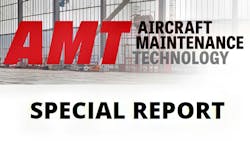Shop Equipment Budget and Investment Trends Report
Aircraft Maintenance Technology (AMT) conducted a survey of aviation maintenance professionals to gather insights on their shop equipment budgeting, purchasing habits and priorities.
The primary respondents to the survey were involved in MRO/Repair Stations (36%), followed by Corporate Flight/Business Operations (28%).
Notably, 90% of respondents have direct or supervisory influence over maintenance work, underscoring the relevance of the survey data to real-world operational decisions.
Data Breakdown at a Glance
Budget Insights
- Budget Allocation: The results indicate a wide variation in annual budgets for shop equipment, with a notable 47.19% of respondents operating with less than $50,000. Meanwhile, a smaller, though significant, portion of the industry has access to more substantial funds, with 8.99% allocating more than $1 million annually.
- Budget Prioritization: When allocating their budgets, 39.33% of respondents dedicate 5-10% to the upgrade and replacement of shop equipment, this could suggest a cautious approach to spending.
Purchasing and Investment Priorities
- Equipment Purchase Plans: Tools and tool storage (80.90%) and inspection and testing equipment (64.04%) emerged as the top categories for recent and planned purchases, underscoring an emphasis on essential maintenance tasks and quality assurance.
- Investment Justification: Immediate operational requirements (51.69%) is the primary consideration for new investments, highlighting the sector's focus on addressing current challenges and ensuring uninterrupted service delivery.
Operational and Strategic Considerations
- Equipment Age and Replacement: The average age of shop equipment skews older, with 26.97% of respondents saying their equipment is more than 15 years old. This could signal an upcoming wave of replacement cycles, driven by the need for modernization and compliance with evolving industry standards.
- Strategic Equipment Assessment: Overwhelmingly, respondents conduct equipment needs and performance assessments as needed, rather than on a regular schedule (47.19%). This reactive approach may suggest the need for more proactive planning strategies to anticipate future equipment needs and budget allocations.
Future Trends and Industry Implications
- Technological Advancements: The industry's inclination towards improved operational efficiency (62.92%) as the most influential factor in adopting new technology points to a growing interest in innovations that can enhance productivity and reduce downtime.
- Financing Methods: A substantial majority (75.28%) prefer upfront capital expenditure for acquiring new equipment, indicating a tendency towards direct investments over leasing or financing options. This preference could reflect a desire for outright ownership or a response to the financial strategies that align with broader economic planning.
- Implementation Timelines: The preference for swift implementation timelines, with 60.67% of respondents favoring less than 6 months from decision-making to operational integration, highlights the industry's urgency in addressing equipment needs and staying competitive.
Data Takeaways
Reflecting on Budget Constraints
Nearly half of the respondents have an annual budget of less than $50,000 for shop equipment. This suggests that a considerable portion of maintenance operations must prioritize spending and potentially defer or carefully select their investments in new technologies and equipment upgrades. For the industry, this could mean a slower pace of technological adoption and innovation, making it critical for suppliers to offer cost-effective solutions that deliver high value.
Immediate Operational Needs Drive Investment
The focus on immediate operational requirements as the primary consideration for new investments (51.69%) showcases the industry's practical approach. While this inclination towards addressing current operational challenges over long-term strategic planning may lead to increased efficiency in the short term, it could pose risks of obsolescence and decreased competitiveness in the long run. There may be a need to balance approaches – consider both current needs and future growth.
Aging Equipment and the Need for Modernization
With a significant portion of shop equipment being more than 15 years old, the industry stands at a potentially critical juncture requiring substantial investment in modernization. This aging infrastructure could hinder the adoption of new technologies and best practices, impacting overall efficiency and safety standards. On the flip side, it represents an opportunity to evaluate the lifecycle costs of maintaining older equipment versus the benefits of investing in newer, more efficient technologies.
Proactive Equipment Management as a Missed Opportunity
The tendency towards reactive equipment assessments, as indicated by 47.19% of respondents, suggests a potential gap in proactive equipment management strategies. Adopting a more systematic and scheduled assessment approach could help identify potential issues before they escalate, optimizing maintenance schedules, and reducing unexpected downtime.
Embracing Technological Advancements
With improved operational efficiency as the driving factor for adopting new technology (62.92%), this signals a readiness among maintenance operations to embrace innovations that enhance productivity. This trend towards technological advancement, despite budgetary constraints, indicates a forward-looking perspective within the industry. It suggests that maintenance operations recognize the potential of technology to transform their processes, improve safety standards, and ultimately deliver better service.
Concluding Thoughts
The data collected by AMT suggests the industry is at a crossroads. Faced with budgetary constraints, an aging fleet of equipment, and the pressing need for modernization, maintenance operations are navigating these challenges with a strategic focus on immediate operational requirements and efficiency improvements. The results of the survey demonstrate the industry's pragmatic approach to investment and resource allocation, balancing the need to address current requirements with an eye towards future readiness and competitiveness.
As the industry grapples with these complex issues, the findings highlight a clear imperative for more proactive planning, investment in technological advancements, and the adoption of cost-effective solutions. Ultimately, the data collected reflects the resilience and adaptability of aviation maintenance professionals, and points to a path forward that embraces innovation, operational efficiency, and strategic growth, ensuring the industry's sustained success in an ever-evolving landscape.
Agree or disagree?
Have a different take on the data? Or see a different path forward that what the data suggests? Let AMT know by emailing editor Walker Jaroch at [email protected].
About the Author
Walker Jaroch
Editor
Contact: Walker Jaroch
Editor | AMT
+1-920-568-8399
>> To download the AviationPros media kits, visit: Marketing Resource Center
>>Check out our aviation magazines: Ground Support Worldwide | Airport Business | Aircraft Maintenance Technology

